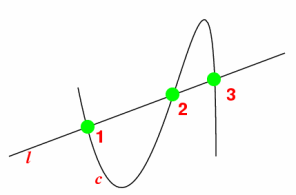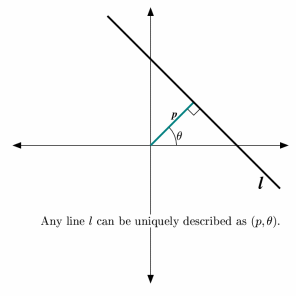
The Cauchy-Crofton Formula1 is:
Theorem: Let c be a regular, plane curve; let m be the measure of all lines in the plane that intersect c (counting multiplicity). Then the length L of c is .5mThe goal of this webpage is to describe the proof using images and applets and to allow the user to explore the concepts used in the proof.

 as
as  , where
p,
, where
p,  are as indicated.
are as indicated.

 ; we'll take
the inherited measure from
; we'll take
the inherited measure from  (area). Therefore the
measure we'll take on the set is
(area). Therefore the
measure we'll take on the set is  . It can be
shown that this measure is invariant under rigid motions (Euclidean
isometries) of the plane. For the details, see (1).
We can now state the Cauchy-Crofton theorem more precisely:
. It can be
shown that this measure is invariant under rigid motions (Euclidean
isometries) of the plane. For the details, see (1).
We can now state the Cauchy-Crofton theorem more precisely:  , where n(p,
, where n(p,  ) is the
number of intersections between the line given by (p,
) is the
number of intersections between the line given by (p,  ) and
the curve c.
) and
the curve c.
Yes, an interesting way.1 Construct a grid of lines
paralell to the x-axis at a distance r apart. Rotate this
family of curves about the origin by 45o( /4),
90o (
/4),
90o (  /2), and 135o (3
/2), and 135o (3  Pi/4) to get four
families of paralell lines.
Pi/4) to get four
families of paralell lines.
Now if a line in the grid intersects a curve n times, there might be
more intersections if we consider all lines in  - we
only know about the grid lines. The parameters of these unknown
lines can range from 0 to r and from 0 to
- we
only know about the grid lines. The parameters of these unknown
lines can range from 0 to r and from 0 to  /4. Therefore we
can approximate the length of c by:
/4. Therefore we
can approximate the length of c by:

The proof is given by 3 steps.
Assume that the curve c is actually a straight line segment. We aim to show that the length of the line is 1/2 times the measure of all lines that intersect c. Following the suggestion of the previous section, use the applet below to explore this concept. Drag the endpoints of the line to desired positions, and hit the "Refine Mesh" button (this better approximates the true measure). You should see the experimental length converging to the actual length.
Proof of step 1: Without loss of generality, we can position
the line c so that the midpoint is at the origin and that c lies on
the x-axis. Recalling our parameterization of lines from before, we
aim to see for a fixed  for which values of p do the lines
intersect c. The picture below clearly illustrates that p can range
from 0 to
for which values of p do the lines
intersect c. The picture below clearly illustrates that p can range
from 0 to  . Therefore
. Therefore


Explore this using the applet below. Move the curve by dragging the red points to new positions. Then hit the "Refine Approximation" button; convince yourself that the length of the segments gets very close to the length of the curve.
Proof of step 2: Up to this point, we haven't been very precise
about defining length. We'll do so now. Suppose that the curve c
is parameterized on the interval [a,b]. Define a partition
 to be an collection of points that subdivides the interval, say
to be an collection of points that subdivides the interval, say
 . Define
. Define  . Then
. Then

It can be shown that this agrees with the intergral definition of
length by using the property  .
.
Bippity, boppity, ...
Proof of step 3: Again, assume c maps [a,b] to  .
Partition [a,b] into n points and use the new points as the vertices of the
polygonal curve in (2). At each point $t_i$, there is a corresponding
triangle T, and the measure of lines that intersect the curve
between
.
Partition [a,b] into n points and use the new points as the vertices of the
polygonal curve in (2). At each point $t_i$, there is a corresponding
triangle T, and the measure of lines that intersect the curve
between  and
and  is less than twice the measure of the
lines that intersect T (if a line l intersects the curve, it must
intersect the triangle twice).
is less than twice the measure of the
lines that intersect T (if a line l intersects the curve, it must
intersect the triangle twice).

As n tends to infinity, notice that  goes to zero by the
definition of derivative, so the measure of the lines that intersect
the triangle tends to twice the measure of the lines that intersect
the line segment. Thus the measure of lines that intersect the curve
segment goes to the measure of lines that intersect the line segment.
Then by (1) and (2), the theorem is proven.
goes to zero by the
definition of derivative, so the measure of the lines that intersect
the triangle tends to twice the measure of the lines that intersect
the line segment. Thus the measure of lines that intersect the curve
segment goes to the measure of lines that intersect the line segment.
Then by (1) and (2), the theorem is proven.
Other than the fact that it's an inherently interesting theorem (it uses simple approximation techniques to arrive at a less than obvious result), the Cauchy-Crofton Theorem a couple of other interesting uses. The approximation above gives a way to roughly calculate the length of a given curve without having to know its equation (as illustrated in the last applet). Also, (1) below mentions that it can sometimes be used to given a meaning of "length" to curves which are non-rectifiable, i.e., the usual integral definition (or the partitition definition) does not apply.
1Most of the information for this page comes from
Differential Geometry of Curves and Surfaces; DoCarmo, M.; 1976.
2The impetus for this project was the
MSRI Summer
School in Mathematical Graphics.
3A special thanks to David Austin and
Bill Casselman for their invaluable help.